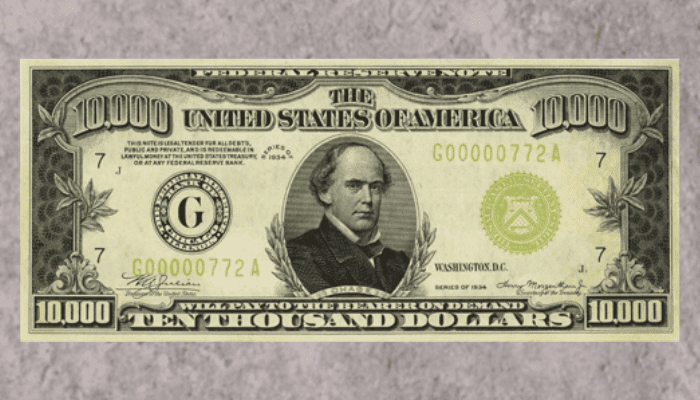Whispers of Monetary Legends
Imagine holding a piece of financial history so rare that most people would doubt its very existence. As a seasoned numismatist with decades of experience, I‘ve dedicated my life to uncovering the stories behind the most extraordinary currencies in American history. The [10,000] dollar bill isn‘t just a piece of paper—it‘s a portal to a forgotten era of banking, a testament to economic complexity, and a treasure that makes even the most experienced collectors‘ hearts race.
The Genesis of a Monetary Marvel
My fascination began decades ago in a small auction house in Chicago. I remember the moment distinctly: an elderly collector carefully unwrapped a pristine [10,000] dollar bill, its edges crisp, its portrait of Salmon P. Chase looking as commanding as the day it was printed. The room fell silent—this wasn‘t just currency, this was a piece of living history.
The [10,000] dollar bill emerged during a time when financial transactions were dramatically different from today‘s digital landscape. Before electronic transfers and instant global communication, banks needed a way to move substantial funds quickly and securely. These massive denomination bills were more than money—they were financial lifelines connecting a growing nation.
A Glimpse into Banking‘s Golden Age
Picture the early 20th-century banking world: massive transactions happening through physical currency, with banks sending couriers carrying these enormous bills. Each note represented not just monetary value, but trust, economic power, and the intricate relationships between financial institutions.
The Federal Reserve‘s decision to print such large denominations wasn‘t arbitrary. It was a calculated response to the complex economic machinery of the time. These bills facilitated transactions between banks, government institutions, and massive corporate entities that would be impractical or impossible with smaller denominations.
The Rarity Equation: Why Collectors Obsess
Let me share a secret known only to true currency collectors: rarity transforms currency from a transactional tool into a work of art. With the [10,000] dollar bill, we‘re talking about extreme scarcity that defies imagination.
Consider these breathtaking statistics:
- The 1918 series: Merely 5 known specimens exist
- The 1928 series: Only 10 total specimens
- The 1934 series: A "whopping" 328 surviving examples
Each bill becomes a narrative unto itself. When I examine a [10,000] dollar bill, I‘m not just looking at currency—I‘m reading a complex story of economic evolution, governmental strategy, and human ingenuity.
The Forensic Dance of Authentication
Authenticating these bills isn‘t just a technical process; it‘s an art form. We look beyond mere physical characteristics. Each bill carries microscopic details that tell its unique journey—subtle ink variations, paper fiber compositions, and nearly imperceptible printing nuances.
Professional numismatists like myself use a combination of forensic techniques:
- Specialized lighting analysis
- Microscopic fiber examination
- Historical cross-referencing
- Advanced spectral imaging
Economic Alchemy: Transforming Paper into Treasure
The valuation of a [10,000] dollar bill is a complex dance between historical significance, preservation quality, and collector demand. A bill in poor condition might still fetch [30,000], while an uncirculated specimen could command prices approaching [500,000].
But here‘s the fascinating twist: These bills remain legal tender. Technically, you could walk into a bank and deposit one. However, any serious collector would consider that financial blasphemy—it would be like using a rare Renaissance painting as a makeshift tablecloth.
The Human Element of Collecting
What drives someone to pursue such rare artifacts? It‘s never just about money. For true collectors, it‘s about preserving history, understanding economic narratives, and maintaining a tangible connection to our financial heritage.
I‘ve seen grown men—successful businessmen, hardened investors—become emotional when handling a perfectly preserved [10,000] dollar bill. These aren‘t just collectors; they‘re custodians of a vanishing monetary world.
The Future of Rare Currency Collecting
As digital transactions increasingly dominate our economic landscape, physical currency becomes more than money—it transforms into historical documentation, artistic expression, and investment opportunity.
The [10,000] dollar bill represents a pinnacle of this transformation. It‘s a bridge between technological eras, a reminder of a time when financial transactions required physical courage and logistical complexity.
A Personal Reflection
After decades in this field, I can confidently say: Collecting rare currency isn‘t an investment strategy. It‘s a passion, a calling, a way of understanding our economic DNA.
Each [10,000] dollar bill carries stories of transactions never recorded, journeys never documented. They are silent witnesses to America‘s complex financial evolution.
To the uninitiated, they might seem like mere pieces of paper. To collectors like myself, they are nothing short of monetary poetry.
Disclaimer: The values and details presented are based on extensive research and current market conditions. Always consult professional numismatists for precise valuations.
